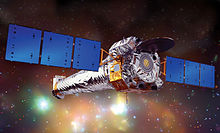Our website is made possible by displaying online advertisements to our visitors.
Please consider supporting us by disabling your ad blocker.
X-ray telescope
This article needs additional citations for verification. (November 2023) |

An X-ray telescope (XRT) is a telescope that is designed to observe remote objects in the X-ray spectrum. X-rays are absorbed by the Earth's atmosphere, so instruments to detect X-rays must be taken to high altitude by balloons, sounding rockets, and satellites.
The basic elements of the telescope are the optics (focusing or collimating), that collects the radiation entering the telescope, and the detector, on which the radiation is collected and measured. A variety of different designs and technologies have been used for these elements.
Many X-ray telescopes on satellites are compounded of multiple small detector-telescope systems whose capabilities add up or complement each other, and additional fixed or removable elements[1][2] (filters, spectrometers) that add functionalities to the instrument.
- ^ "Chandra :: About Chandra :: Science Instruments". chandra.si.edu. Retrieved 2016-02-19.
- ^ "Instruments". sci.esa.int. Retrieved 2016-02-19.
Previous Page Next Page


